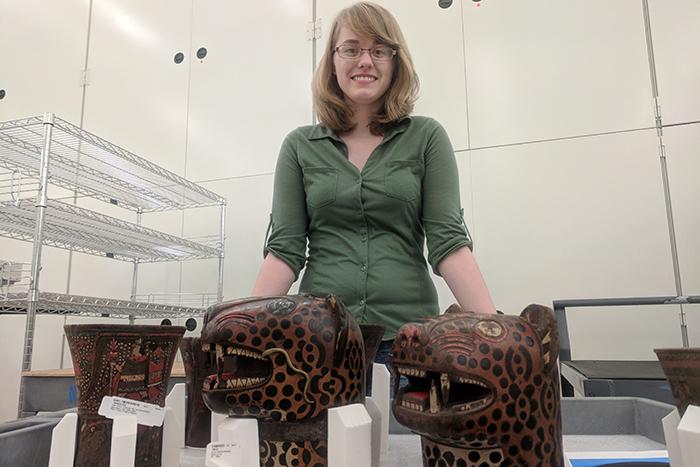Dickinson College Student-Faculty Research Reveals New Historical Context for Andean Drinking Vessels

Allison Curley '19 with qeros from the collection of the Smithsonian National Museum of the American Indian. Photo by Alyson Thibodeau.
Geochemistry provides insights into longstanding historical questions
by Craig Layne
New research by a Dickinson alumna and professor could help museums, conservators, historians and scholars better understand the timeline and production of Andean ceremonial drinking vessels known as qeros. Allison Curley ’19 and Assistant Professor of Earth Sciences Alyson Thibodeau recently published their findings in the journal Heritage Science.
Using isotope analysis of the lead white pigments in the decorative patterns on qeros from the colonial period (1532-1821), they found only three isotope signatures among these culturally significant objects. Two of these isotopic signatures, present on a total of eight qeros, are the same as found in lead white paints used in European artwork from the same period. This match suggests these qeros are decorated with pigments imported to the Andes from Europe. The third signature, found on 12 of the qeros, suggests that the lead white was manufactured locally in the Andes.
“The consistency of the data was both surprising and satisfying,” said Curley, who has been collaborating with Thibodeau on this project since 2017.
Toasting in the Andes
Ceremonial drinking vessels have been used for toasting rituals in the Andes for millennia. Wooden qeros made in the colonial period were typically fabricated in identical pairs to make ceremonial toasts for social, political and religious occasions. These items retain their cultural significance to this day and are recognized as a symbol of the Inka Empire. Because they provide a window into the Andean indigenous colonial experience, qeros have been studied by art historians, archaeologists and anthropologists.
“Little is known about the provenance history of colonial qeros now in museum or private collections. The results could lead to a better understanding of the objects’ chronology and production,” explained Thibodeau. “For example, it is possible that qeros made earlier in the colonial period are decorated with European lead white, while qeros made later are decorated with lead white made from Andean ores. Further, the results strongly suggest some form of centralization in pigment acquisition, manufacture and distribution in the colonial period.”
Collaborating with luminaries
“It is exciting to see geochemistry provide insights into some longstanding historical and archaeological questions, and I was absolutely thrilled to present these findings to the Society for American Archaeology and to the conservators at the Smithsonian,” said Curley.
Now a graduate student in the University of Michigan’s department of earth & environmental sciences, Curley is the lead author of the study. She and Thibodeau collaborated with a team including researchers from the Smithsonian National Museum of the American Indian (NMAI); the Metropolitan Museum of Art; the UCLA/Getty Program in Conservation of Archaeological and Ethnographic Materials; and the American Museum of Natural History.
“Allison presented the initial stages of this research in 2018 in a symposium titled ‘Contextualizing Museum Collections at the Smithsonian Institution,' ” explained Emily Kaplan, a co-author on the study and conservator at the NMAI, which has the largest collection of qeros in the United States. “She was the sole undergraduate presenting in a session full of luminaries in the field of archaeology, and I was not alone in thinking her presentation was one of the best.”
Now that the paper has been published, Kaplan has invited Curley and Thibodeau to present an update to the NMAI Conservation Department, as part of a series of weekly Zoom talks the museum has organized during the COVID-19 shutdown.
“It’s important for those studying qeros all over the world to have a better understanding of the Andean people who made and used qeros during a time of colonial rule,” said Kaplan. “Style and iconography have been used to help establish production timelines, but there’s a lot of guesswork involved,” she said. Kaplan hopes the research will lead to more radiocarbon dating, which will reveal more about the chronology of qero production.
TAKE THE NEXT STEPS
Published July 31, 2020